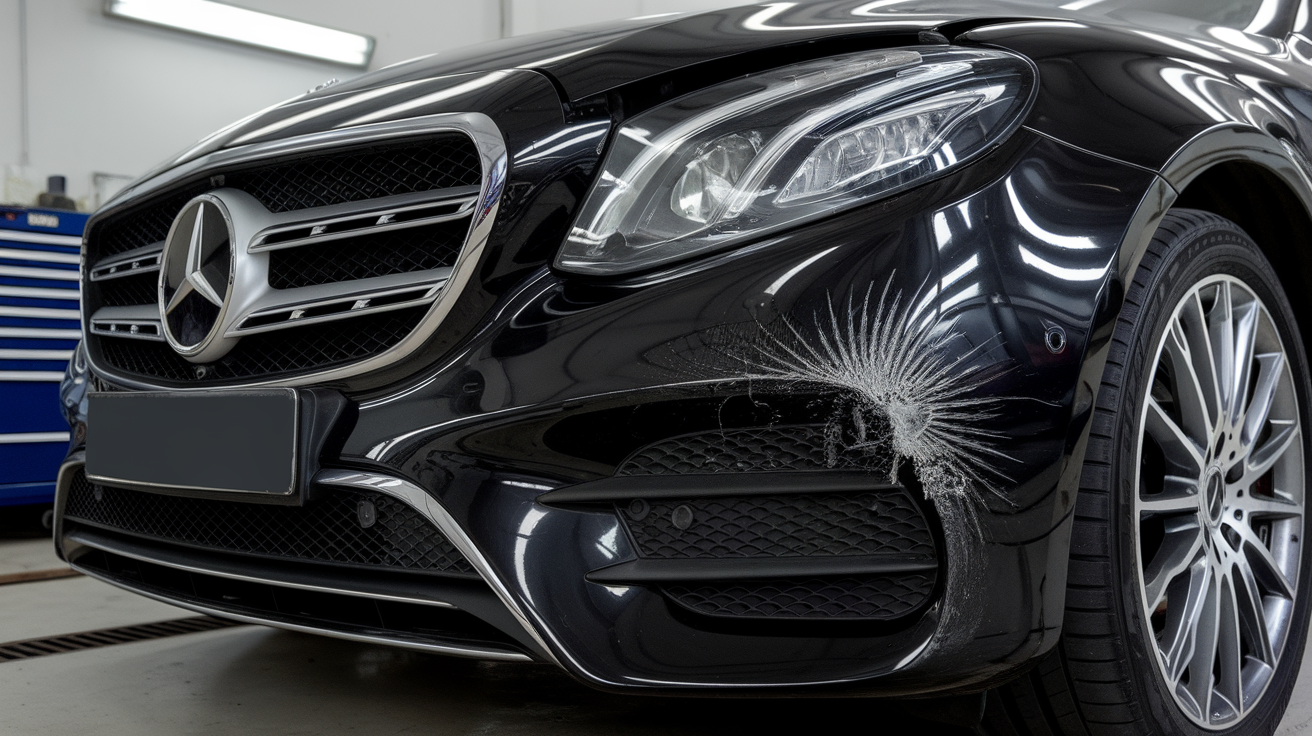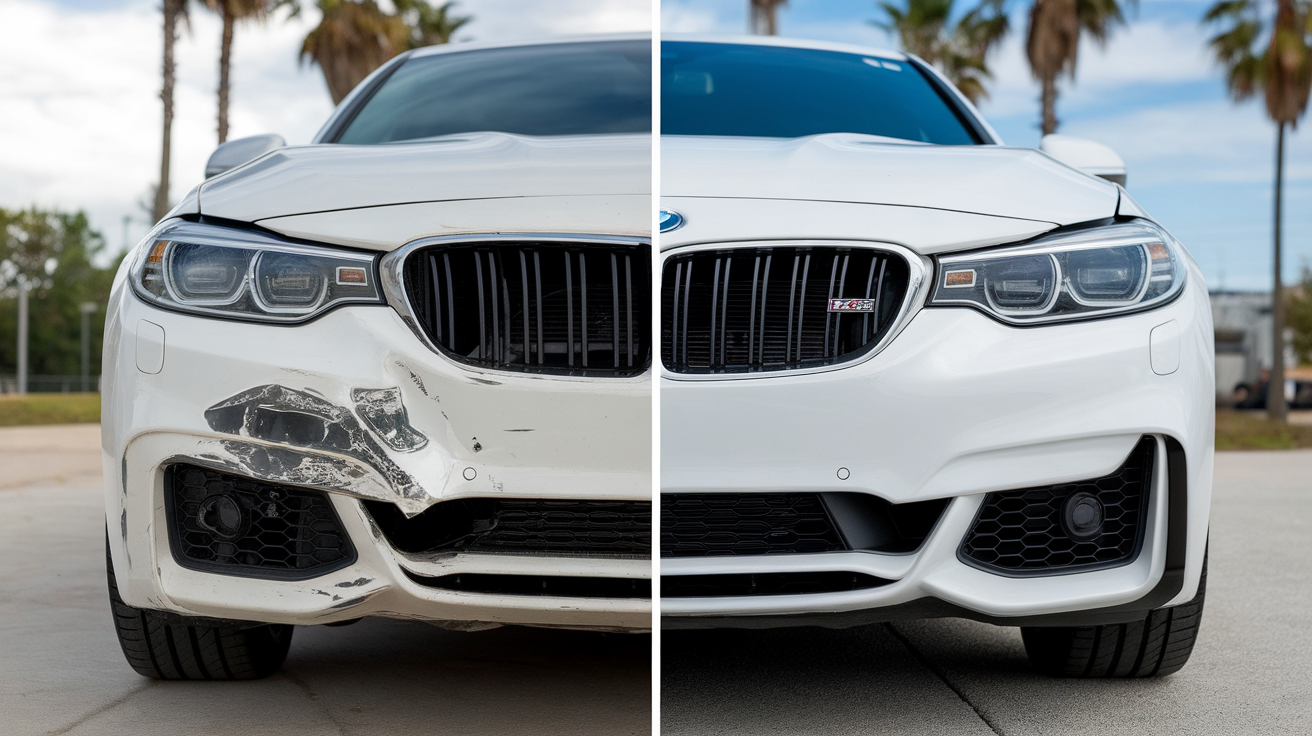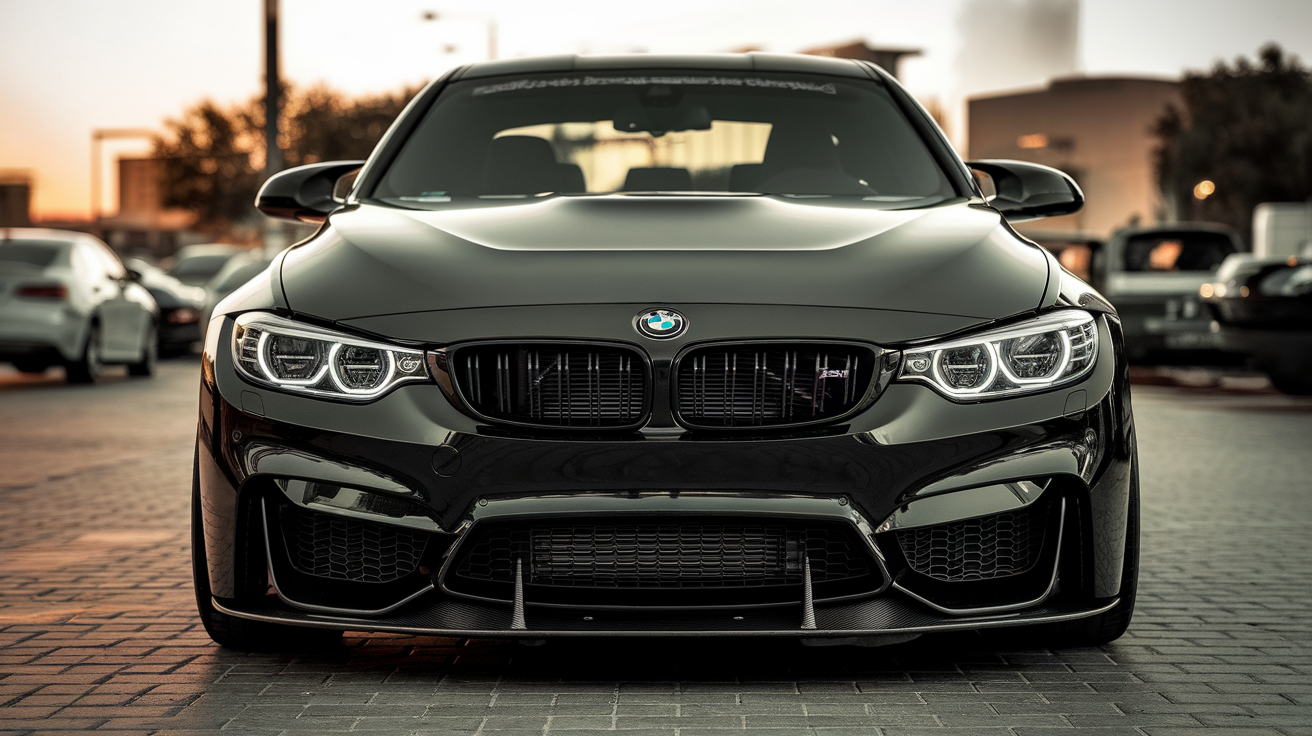Ever wondered why some bumper repairs last while others crack within weeks? It is not always about who is fixing it, but what they are fixing it with. In the world of car bumper repair, using the wrong tool can wreck the finish, weaken the structure, or worse, compromise safety. Whether you are dealing with minor bumper damage, a nasty dent, or a cracked corner after a parking lot scrape, having the right bumper repair tools changes everything. This guide walks you through the best tools for efficient car bumper repairs, built for accuracy, durability, and real results, especially under Dubai’s heat and driving pressure.
Types of Car Bumper Damage
Think your bumper just took a scratch? What if that scratch is hiding a deeper crack that grows with every mile? That is the problem with underestimating bumper issues. What looks like a light scuff may be a serious case of car bumper damage, especially in Dubai, where extreme heat, traffic chaos, and tight parking all add to the risk. Here’s a breakdown of the most common types of automotive bumper damage and what tools are actually needed to fix them the right way:
- Minor Surface Scratches & Paint Scuffs
These happen often due to parking lot brushes, sand particles, or accidental contact. Even though they may look harmless, these still require refinishing tools, abrasives, and precision sprayers to correct without repainting the full bumper. - Bumper Dents & Flex Marks
Whether from reversing into a pillar or getting nudged in stop-and-go traffic, bumper dents distort the shape of the plastic shell. This type of plastic bumper damage is usually handled with heat reshaping, PDR tools, or suction-based pullers to restore form without cracking the paint. - Visible Cracks or Splits
A visible bumper crack means the plastic structure is compromised. This is serious. Most Dubai repair shops rely on plastic welding tools, reinforcement mesh, and strong adhesives to restore integrity and avoid complete replacement. - Punctures or Deep Holes
Shopping carts, rebar, or sharp metal corners, these tear through plastic with ease. Puncture repair requires advanced bumper reshaping tools, layered filling, and a complete respray for durability. Simply filling it with putty never lasts. - Warped or Misaligned Bumper Edges
Dubai’s heat can actually cause poorly repaired bumpers to warp over time. Add that to impact pressure or incorrect installation, and your bumper no longer aligns. Realignment takes more than clips; it needs heat guns, clip removal tools, and reformation techniques.
Each type of car bumper damage demands a different set of bumper repair tools. Using the wrong approach not only wastes time but can also make the damage worse, sometimes irreversible. And that is exactly why we never guess. Every dent, split, or warp has a cause, and the right tool is what makes the difference between a temporary patch and a long-lasting fix.

Why Heat Guns & Plastic Welders Matter in Car Bumper Repair
If your bumper is bent, cracked, or warped, heat and welding are not optional; they are the fix. In Dubai’s high-traffic, high-heat environment, most car bumper damage needs more than patchwork. To reshape and restore it properly, you need the right bumper repair tools, starting with these two.
Heat Gun for Bumper Repair
To reshape plastic, you need precise heat, not random.
- Heats plastic to reform dents, folds, and warped edges
- Operates between 300°C and 350°C for safe plastic memory restoration
- Used in bumper reshaping, especially after minor collisions
- Helps avoid paint blistering when applied evenly
Without the right heat level, your bumper either stays deformed or ends up melted. In most Dubai jobs, the heat gun is the tool that brings the shape back without replacing the entire panel.
Plastic Welding Tools
Cracks do not need glue; they need fusion.
- Melts cracked bumper edges and bonds them together
- Often combined with hot staples, wire mesh, or rods for strength
- Works best on plastic bumper splits, punctures, and torn corners
- Restores flexibility and shock absorption in plastic panels
This is not a cosmetic fix; it is structural. If your plastic bumper is split, only plastic welding tools can truly restore it. Anything else is a temporary patch.
Heat reshaping and plastic welding are the foundation of long-lasting automotive plastic repair. Without them, the damage returns and is usually worse than before.
Smart Dent Removal Tools We Use in Car Bumper Repairs
Not every bumper dent needs repainting or replacement. In many cases, a precise tool in the right hands is enough to bring back shape and strength without touching the paint. That is exactly how we handle most car bumper repairs in our Dubai shop. Here are the 6 key tools we use for safe and clean bumper dent removal:
- Hot Glue Tab Pullers
These use heat-safe glue tabs stuck directly to the dent. A mini lifter or slide hammer pulls the panel outward. Best for soft plastic dents where you want to avoid sanding or filler. - Suction Cup Pullers
These work on large, shallow dents by pulling the surface out with air pressure. No adhesives needed. Ideal for plastic bumpers right after impact, before the dent shape sets permanently. - Paintless Dent Repair Rods
Also known as PDR tools, these are long rods that go behind the bumper. They push dents out slowly without damaging the paint. Common in bumper reshaping for creased or folded corners. - Slide Hammers with Adapter Tabs
Used when the plastic is stiff or the dent is deeper. The tool grips onto tabs and applies pulling force. Often followed by heat reshaping to restore contour. - Heat & Pull Combo Tools
Some bumper dents need a mix of heat and pull to respond. These setups use infrared or electric heat along with suction or glue-pulling methods. This softens the plastic before reshaping. - Bumper Reshaping Kits
These are full kits that include dent pushers, heat guns, contour pads, and shaping tools. They allow for controlled car bumper repair without over-stretching or cracking the surface.
The right tool makes all the difference. We do not patch dents; we repair them based on shape, plastic condition, and impact depth. That is how we protect your original finish while making sure the bumper repair actually lasts. Want to dive deeper into how these kits work? Check out our guide on Pulling Kits for Dent Repair to see why they’re essential in modern body shops.

Sanding & Grinding Tools | We Use to Prepare Bumpers for Painting
When we talk about finishing a bumper, it is not just about paint; it’s about making the surface right. In most car bumper repairs, the real difference shows up during the final smoothing stage. That means using the right abrasives and the right motions and never cutting corners, literally. Below are the specific tools we rely on for surface correction and paint prep:
- Electric Flat Sanders
These tools flatten out body filler and weld areas without dragging or digging into the plastic. They’re used for controlled removal across wide, previously repaired sections. - Foam-Backed Abrasive Sheets
Designed for bumpers with complex shapes. These sheets bend with the surface to maintain factory curves and reduce high spots around the edges. - Contour Refinement Blocks
Manual blocks shaped for long sweeping motions on curved bumpers. They allow us to feel the panel while working, catching subtle rises or low spots before primer is applied. - Edge Detail Smoothers
Narrow tools fitted with light abrasives for cleaning up sharp corners, sensor zones, and inner lips without flattening critical lines. - Paint Surface De-Gloss Pads
These remove the gloss from surrounding paint zones when blending new paint into old areas. Essential during partial bumper resprays or smart repairs. - Controlled-Speed Die Grinders
Used when older bumper coatings or thick textured paint must be stripped completely before restoration. Speed control keeps heat levels safe for plastic. In fact, when heavy coatings need to come off cleanly, we often use professional-grade Paint Stripper solutions before sanding. This ensures a smooth base for primers and color coats, especially on plastic bumpers.”
These are not just tools; they’re safeguards. In car bumper repairs, one rough grit or wrong motion can undo hours of careful work. That is why surface correction is never rushed. We match the tool to the bumper material, shape, and finish goals, so nothing stands out after painting.
Spray Painting Tools We Use to Finish Car Bumper Repairs
After shaping and sanding, a bumper still needs one last thing to look new: paint. But not just any paint. In most car bumper repairs, the final result depends on how the paint is applied. Plastic needs a specific method, speed, and set of tools to hold color properly and resist peeling later. Here are the spray painting tools we use during the bumper refinishing stage:
- HVLP Paint Guns
These spray guns give a fine, wide pattern with less air pressure. That means smoother coats on plastic bumpers without wasting paint or leaving thick spots. - Mini Detail Guns
Small-sized spray tools for hard-to-reach bumper areas like corner edges and sensor holes. Helps avoid overspray and gives clean paint lines. - Mixing Cups & Scale Stations
We mix each paint based on color codes and temperature. Using these tools ensures the exact formula matches your car’s original paint, even on faded plastic. - Paint Filters & Strainers
Before spraying, we filter the paint to remove dust or tiny particles. This prevents clogging and keeps the finish clean and even. - Infrared Dryers
These help cure paint faster on plastic bumpers without shrinking or warping. It also reduces the risk of dirt sticking during the drying process. - Masking & Edge Taping Tools
Used to cover nearby panels, lights, and trims. Ensures that only the bumper is sprayed; no paint ends up on other areas.
Without the right painting tools, even a perfect repair can go wrong. Uneven spray, paint drips, or color mismatch usually come from poor application, not bad materials. That is why every car bumper repair in our Dubai shop goes through a controlled painting process with tools built for plastic.

Cost vs Quality | Choosing Tools That Last in Car Bumper Repairs
If you run a repair shop or care about long-term results, the tools you use are just as important as the repair itself. Many low-cost tools offer quick fixes but end up causing uneven results, repeated failures, or even panel damage, especially in complex car bumper repairs.Choosing the right tool is not just about how much it costs upfront; it is about how well it performs after 20, 50, or 100 jobs. Here’s a breakdown that shows how we evaluate tool quality when it comes to bumper repair efficiency and long-term performance.
| Factor | Low-Cost Tools | Professional-Grade Tools |
| Initial Cost | Affordable, short-term saving | Higher, but with long-term return |
| Durability | Often breaks or wears out after repeated use | Built for extended shop use and frequent repairs |
| Repair Precision | Limited control; more margin for error | Better accuracy on heat, pressure, and shaping |
| Plastic Compatibility | Not always safe for plastic bumpers | Designed specifically for thermoplastics and bumper materials |
| Finish Quality | May require rework or lead to visible panel distortion | Delivers smooth, paint-ready results consistently |
| Safety & Heat Control | Poor insulation; risk of overheating or melting | Calibrated for controlled temperature and safe operation |
| Downtime Impact | Frequent tool replacement disrupts workflow | Fewer breakdowns, more uptime, better overall shop efficiency |
| Support & Spare Parts | Rare or unavailable | Easy to service, with brand support and parts access |
Customers do not see the tools, but they always see the result. In our Dubai shop, the best car bumper repairs come from tools that hold up over time, adapt to multiple bumper types, and do not compromise on the finish.
Tools We Use to Remove & Install Bumpers Safely During Car Bumper Repairs
Removing a bumper may seem simple, but if it’s forced or rushed, the clips break, sensors fail, and the fitting never aligns again. For proper car bumper repairs, taking the bumper off and reinstalling it safely is a critical step. These are the tools that help us do that right every time.
- Plastic Clip Removers
These tools slide under bumper fasteners to pop them out without breaking. Designed to handle all types of plastic push clips, especially on modern bumpers with hidden anchors. - Panel Clip Pliers
Used to squeeze and release locking tabs deep inside the bumper. They allow access to tight areas behind the wheel liner or under the grille without scratching nearby parts. - Trim & Molding Removers
Flat tools that remove bumper trims, sensors, and camera covers without bending or damaging the plastic. Helps during disassembly for repaint or sensor recalibration. - Torque Wrenches
Ensures all bumper bolts are tightened evenly during installation. Avoids under-tightening (which causes movement) or over-tightening (which cracks plastic or misaligns parts). - Magnetic Screw Holders & Bit Drivers
Helps during bumper refits by holding screws at awkward angles. Especially useful for reinstalling brackets and internal bumper supports. - Bumper Alignment Guides
Used during refitting to align bumper holes, tabs, and supports. Prevents uneven gaps, loose fit, or trim stress once everything is locked in.
In bumper removal, breaking a clip means more than a small loss; it weakens the hold of the entire panel. That is why we use purpose-built tools that work with plastic, not against it, during every stage of car bumper repair.
When it comes to car bumper repairs, the tools you use define the result. From dent removal to paint application, every step demands precision. Using the wrong equipment leads to uneven finishes, misaligned fittings, and costly rework, especially in Dubai’s harsh driving and weather conditions. That is why proper tools are not optional; they are the backbone of real, long-lasting bumper restoration.
If you want repairs that look clean, fit tight, and hold up under pressure, bring your car to a workshop that does it right the first time. Our team uses only advanced, vehicle-safe tools for every stage of car bumper repair, from inspection to finishing. Book your appointment now or call us today; we’re here to restore your bumper the right way, with tools built for the job.



